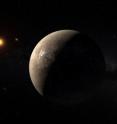Rocky planet found orbiting habitable zone of nearest star
Related images
(click to enlarge)
An international team of astronomers including Carnegie's Paul Butler has found clear evidence of a planet orbiting Proxima Centauri, the closest star to our Solar System. The new world, designated Proxima b, orbits its cool red parent star every 11 days and has a temperature suitable for liquid water to exist on its surface, if it were present. This rocky world is a little more massive than the Earth and is the closest exoplanet to us; it may even be the closest possible abode for life beyond our own Sun. A paper describing this milestone finding is published by Nature. Just over four light-years from our Solar System sits a red dwarf star named Proxima Centauri. This cool star in the constellation of Centaurus is too faint to be seen with the naked eye and is close to the much brighter pair of stars known as Alpha Centauri A and B.
During the first half of 2016, the HARPS spectrograph on the European Southern Observatory's 3.6-meter telescope at La Silla regularly observed Proxima Centauri, as did other professional and amateur telescopes around the world. The team of astronomers, called the Pale Red Dot campaign, led by Carnegie alum Guillem Anglada-Escudé of Queen Mary, University of London was looking for a tiny back-and-forth wobble in the star caused by the gravitational pull of an orbiting planet.
In addition to data gathered by the Pale Red Dot campaign, the paper incorporates contributions from scientists who have been observing Proxima Centauri for years, including Butler.
As this was a topic with very wide public interest, the progress of the campaign between mid-January and April 2016 was shared publicly as it occurred on the Pale Red Dot website and via social media. Numerous outreach articles from specialists all around the world accompanied the reports on data collection.
Anglada-Escudé explains the background to this unique search: "The first hints of a possible planet were spotted back in 2013, but the detection was not convincing. Since then we have worked hard to get further observations off the ground with help from ESO and others. The recent Pale Red Dot campaign has been about two years in the planning."
The Pale Red Dot data, when combined with earlier observations, revealed a truly exciting result. At regular intervals, Proxima Centauri is approaching Earth at about 5 kilometers per hour--normal human walking pace--and at opposite times in those cycles it is receding at the same speed. This regular pattern repeats with a period of 11.2 days. Careful analysis of how tiny the resulting Doppler shifts were showed that they indicated the presence of a planet with a mass at least 1.3 times that of the Earth, orbiting about 7 million kilometers from Proxima Centauri--only 5 percent of the distance between the Earth and the Sun.
One complication to the analysis is that red dwarfs like Proxima Centauri are active stars, and their natural brightness variations could mimic the presence of a planet. In order to exclude this possibility, the team also monitored the changing brightness of the star very carefully during the campaign using the ASH2 telescope at the San Pedro de Atacama Celestial Explorations Observatory in Chile and the Las Cumbres Observatory Global Telescope Network.
Although the planet companion, Proxima b, orbits much closer to its star than Mercury does to the Sun in our Solar System, the star itself is far fainter and cooler than the Sun. As a result, Proxima b has an estimated temperature that--if water were present--would allow it in a liquid state on its surface, thus placing it within the so-called "habitable zone" around the star.
Despite the temperate orbit of Proxima b, the conditions on the surface may be strongly affected by the ultraviolet and x-ray flares from the star--far more intense than the Earth experiences from the Sun.
"The discovery of the potentially habitable planet around Proxima Cen is the culmination of 30 years of work that has improved stellar velocity measurement precision from 300 m/s to 1 m/s," Butler said. "This work has resulted in the discovery of hundreds of planets around the nearest stars, and now a potentially habitable planet around the nearest star in the sky. This work confirms the Kepler satellite and precision velocity studies that have shown that potentially habitable planets are common, and points the way to the future when such planets will be directly observed with giant ground- and space-based telescopes."
Source: Carnegie Institution for Science
Articles on the same topic
- Planet found in habitable zone around nearest starWed, 24 Aug 2016, 17:38:02 UTC
Other sources
- Our Interstellar Neighbors: 5 Potentially Earth-Like Planets Nearbyfrom Space.comTue, 6 Sep 2016, 12:01:19 UTC
- Proxima b could be a life-friendly planet, says one of the co-discoverersfrom PhysorgMon, 5 Sep 2016, 10:31:32 UTC
- Rocky planet found in habitable zone around Sun's nearest neighbourfrom Physics WorldMon, 5 Sep 2016, 7:31:28 UTC
- Image: Hubble's best image of Alpha Centauri A and Bfrom PhysorgFri, 2 Sep 2016, 13:01:31 UTC
- Is the Nearest Alien Planet Proxima b Habitable? 'It's Complicated'from Space.comWed, 31 Aug 2016, 17:51:12 UTC
- The crazy quest to send spaceships to an Earth-like planet at Alpha Centaurifrom CBC: Technology & ScienceTue, 30 Aug 2016, 21:11:22 UTC
- New discovery Proxima b is in host star's habitable zone—but could it really be habitable?from PhysorgTue, 30 Aug 2016, 11:11:23 UTC
- Geospatial expert on newly discovered planet Proxima bfrom PhysorgTue, 30 Aug 2016, 10:41:19 UTC
- Proxima b: Could life exist on Earth-like planet in the solar system next door?from Science BlogTue, 30 Aug 2016, 10:21:15 UTC
- Earth-Mass Planet Right Next Doorfrom Newswise - ScinewsMon, 29 Aug 2016, 18:01:34 UTC
- What If Scientists Found Life on Closest Alien Planet Proxima b?from Live ScienceFri, 26 Aug 2016, 20:11:27 UTC
- Proxima b: Lasers Might One Day Power Ship to Closest Alien Planetfrom Live ScienceFri, 26 Aug 2016, 15:42:39 UTC
- Explore Proxima Centauri, Home of Proxima b, in Slooh Webcast Tonightfrom Space.comFri, 26 Aug 2016, 12:31:17 UTC
- Newly-discovered planet has similarities to Earthfrom CBSNews - ScienceThu, 25 Aug 2016, 13:31:28 UTC
- What's It Like On Our Neighbor, Proxima b?from Space.comThu, 25 Aug 2016, 12:01:16 UTC
- Why Did It Take So Long to Find Proxima b?from Space.comThu, 25 Aug 2016, 12:01:15 UTC
- Rocky planet found in habitable zone around Sun's nearest neighbourfrom Physics WorldThu, 25 Aug 2016, 4:01:25 UTC
- ESO Discovers Earth-Size Planet in Habitable Zone of Nearest Starfrom NASA Jet Propulsion LaboratoryWed, 24 Aug 2016, 23:01:25 UTC
- Aliens Next Door: Does Proxima b Host Life?from Space.comWed, 24 Aug 2016, 22:31:20 UTC
- How We Could Visit the Possibly Earth-Like Planet Proxima bfrom Space.comWed, 24 Aug 2016, 22:31:19 UTC
- Forget the Moon. Future Travel Plans Could Include Trips to Proxima Centauri, Says Cornell Astronomerfrom Newswise - ScinewsWed, 24 Aug 2016, 21:51:21 UTC
- New Planet 2016: Complete Coverage of Proxima b's Discoveryfrom Space.comWed, 24 Aug 2016, 20:41:12 UTC
- Planet found in habitable zone around nearest starfrom Science DailyWed, 24 Aug 2016, 19:41:38 UTC
- One Star Over, a Planet That Might Be Another Earthfrom NY Times ScienceWed, 24 Aug 2016, 19:41:13 UTC
- Planet Found in Habitable Zone Around Nearest Starfrom Newswise - ScinewsWed, 24 Aug 2016, 18:51:12 UTC
- Proxima Centauri's Alien Planet Closer Than You Think - With Right Spacecraft | Videofrom Live ScienceWed, 24 Aug 2016, 18:31:13 UTC
- Earth-sized planet around nearby star is astronomy dream come truefrom News @ NatureWed, 24 Aug 2016, 18:11:13 UTC
- Astronomers find second Earth just 4.25 light-years awayfrom UPIWed, 24 Aug 2016, 18:01:20 UTC
- Alien World 'Proxima b' Around Nearest Star Could Be Earth-Like | Videofrom Live ScienceWed, 24 Aug 2016, 18:01:17 UTC
- 8 Most Intriguing Earth-Like Planetsfrom Live ScienceWed, 24 Aug 2016, 18:01:15 UTC
- Scientists find Earth-like planet circling sun's nearest neighborfrom Reuters:ScienceWed, 24 Aug 2016, 17:41:14 UTC
- The Earth Next Doorfrom Scientific AmericanWed, 24 Aug 2016, 17:31:50 UTC
- Earth-like planet found orbiting the star next doorfrom CBC: Technology & ScienceWed, 24 Aug 2016, 17:31:48 UTC
- Possibly habitable planet found orbiting nearest starfrom CBSNews - ScienceWed, 24 Aug 2016, 17:31:47 UTC
- Just 4.2 light-years away, scientists spot a rocky, Earth-like planet that could have liquid waterfrom LA Times - ScienceWed, 24 Aug 2016, 17:31:46 UTC
- Five ways Proxima b find is importantfrom BBC News: Science & NatureWed, 24 Aug 2016, 17:31:29 UTC
- Earth-sized world 'around nearest star'from BBC News: Science & NatureWed, 24 Aug 2016, 17:31:28 UTC
- Found! Potentially Earth-Like Planet at Proxima Centauri Is Closest Everfrom Live ScienceWed, 24 Aug 2016, 17:31:21 UTC
- Alien World 'Proxima b' Around Nearest Star Could Be Earth-Like | Videofrom Space.comWed, 24 Aug 2016, 17:31:20 UTC
- Proxima b: 6 Strange Facts About a Potentially Earth-Like Exoplanetfrom Space.comWed, 24 Aug 2016, 17:31:19 UTC
- Proxima Centauri's Alien Planet Closer Than You Think - With Right Spacecraft | Videofrom Space.comWed, 24 Aug 2016, 17:31:18 UTC
- Proxima b By the Numbers: Possibly Earth-Like World at the Next Star Overfrom Space.comWed, 24 Aug 2016, 17:31:18 UTC
- Found! Potentially Earth-Like Planet at Proxima Centauri Is Closest Everfrom Space.comWed, 24 Aug 2016, 17:31:17 UTC
- Proxima b: Closest Earth-Like Planet Discovery in Picturesfrom Space.comWed, 24 Aug 2016, 17:31:16 UTC
- Jackpot: Scientists find Earth-like planet at star next doorfrom AP ScienceWed, 24 Aug 2016, 17:11:15 UTC
- Rocky planet found orbiting habitable zone of nearest starfrom PhysorgWed, 24 Aug 2016, 17:01:48 UTC
- Proxima Centauri: Our Closest Stellar Neighbor - Statistics | Videofrom Live ScienceMon, 22 Aug 2016, 22:31:17 UTC
- Proxima Centauri: Our Closest Stellar Neighbor - Statistics | Videofrom Space.comMon, 22 Aug 2016, 20:01:37 UTC

